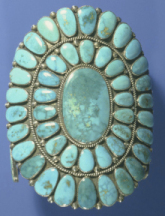The possibility exists, however, that nophek could better be rendered as "turquoise" given that six out of the ten Bible versions used for comparison purposes in this series translate it as such. These same six Biblical translations also translate nophek, stated as the eighth stone which adorned the symbolic King of Tyre (Ezekiel 28:13) which represented a fallen Lucifer, as "turquoise."
The origin of the English word for this precious gem actually comes from the French word for Turkey (Turks or Turkish). At one time, it was believed that this location is where the gem was discovered and sent to Europe.
According to a USGS article on turquoise, a robin's egg blue version of this stone was worn by Aztec kings and the Pharaohs of Egypt. This gemstone is believed to have been one of the first ones found and utilized by man. Two of the oldest known areas for mining this stone are the Alimersai Mountain in Iran and in Egypt's Sinai Peninsula. In modern times, the United States is the world's largest producer of this stone.

In the early seventeenth century it was stated that no Englishman (women rarely wore the gem) considered his hand "well adorned" unless he wore on it a quality turquoise stone (Curious Lore of Precious Stones, page 111).
Folklore
Turquoise, like diamonds, were once believed to possess talisman-like powers. These powers, however, would only manifest themselves if the precious stone were received as a gift. If the gem was purchased, its power was believed to leave it and render it useless (Curious Lore of Precious Stones, page 73).
This gemstone was believed to protect the wearer if he or she fell and to signal an approaching disaster by breaking into several pieces. Horses that wore the stone were protected from the bad effects of drinking cold water after exertion (ibid. page 109).
Skepticism regarding the seeming magical powers of stones has been voiced throughout history. One such example occurred during the reign of Emperor Charles V (who ruled over the Holy Roman Empire from 1519 to 1556 A.D.). When Charles asked a court jester, "What is the property of the turquoise?" he got the following response.
"'Why,' replied he (the jester), 'if you should happen to fall from a high tower whilst you were wearing a turquoise on your finger, the turquoise would remain unbroken'" (ibid. page 24).